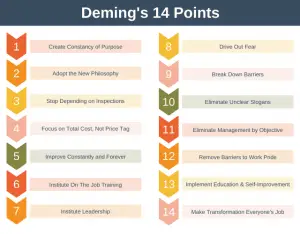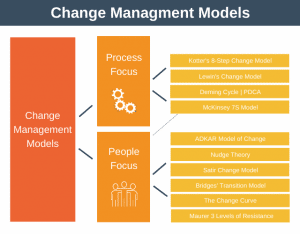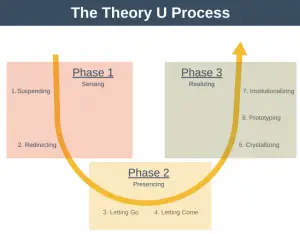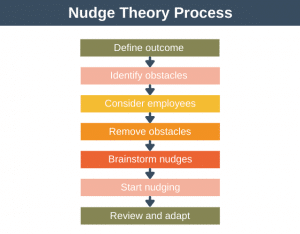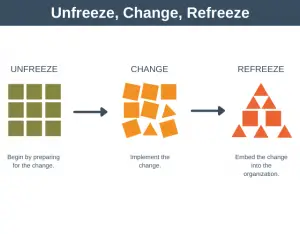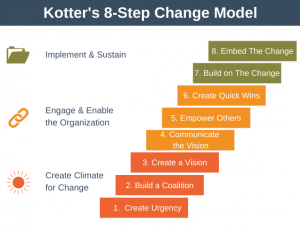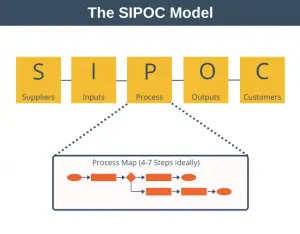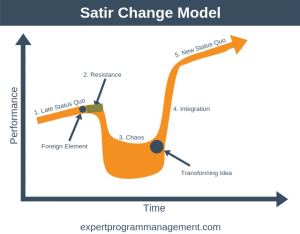Bridges Transition Model is a three-stage model that enables you to understand and manage the human side of change more effectively.
All organizations must change to survive. If you continue doing what you’ve always done, your organization will eventually become outdated, uncompetitive, and obsolete. Thus, change is inevitable and essential in every organization.
As a leader, when you think about any change initiative, it is natural to think first about the outcome you are trying to achieve and then create a plan to get you there step by step. You then have to execute the steps contained within the plan to reach your destination.
Unfortunately, approaching organizational change in this way can often lead to failure. To understand why, you need to understand a concept at the core of the Bridges Transition Model: the difference between change and transition.
Change
Change is external to people within the organization and happens to them whether they like it or not.
There are many types of organizational change, including a merger or acquisition, creating and launching a new product, and implementing a new business strategy.
Change is concerned with achieving outcomes.
Transition
If change is external, then transition is internal. Transition is the internal psychological process that change puts people through.
It is how people feel as they process and come to terms with the new situation that change brings about. A transition occurs in the course of every attempt to change.
Unfortunately, most leaders concentrate on change and assume that transition will happen simply because the change is happening; this, unfortunately, isn’t the case.
Change can happen very quickly, whereas transition usually takes longer.
Bridges Transition Model
Bridges Transition Model is based on the idea that change will only be successful if employees are supported through the transition they experience during change. Essentially, you need to bring people with you if you want your change initiative to succeed.
The Bridges Transition Model helps organizations manage change successfully by mapping out the human response to change over three stages. These are:
- Ending, Losing, and Letting Go: allow people to let go and say goodbye to old ways.
- The Neutral Zone: the in-between time when the old is no more, but the new hasn’t arrived yet.
- The New Beginning: the confusing time when people begin to engage in their new future.
As you can see from the diagram below, the three stages aren’t discreetly demarked and can coexist at the same time within a change.
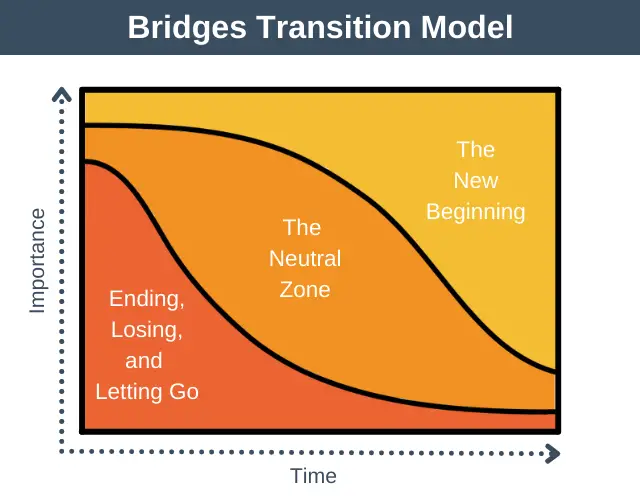
In the diagram, you can see how the relative importance of each stage changes as time goes by.
You may also see Bridges Transition Model drawn as follows, to show how employee productivity changes as you progress through a transition.
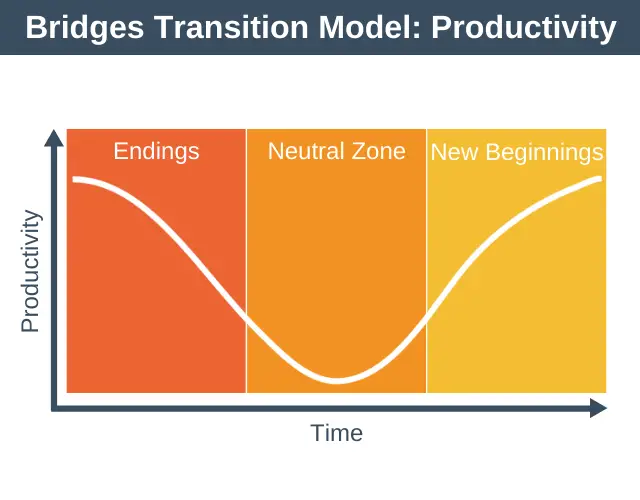
It’s worth noting that the greater your seniority with your organization, the more quickly you are likely to move through the transition process. This is often because you understand the need for change long before others in your organization. This means that as a senior manager, it can be easy to forget that others will take longer to transition.
Bridges Transition Model Stages
Let’s dig a little deeper into each of the three stages. Note that each stage can be upsetting for people to spend time in.
1. Ending, Losing, and Letting Go
People have to let go of how things were, and they also have to let go of how they were or used to be. Some things they might need to leave behind include relationships, team members, processes, etc.
This stage often percolates feelings of resistance and emotional upheaval, as employees are forced to give up something they are familiar and comfortable with. Just think how you would feel if you had been happily doing the same job for twenty years and suddenly everything was changing.
Common feelings for people to feel during this stage include:
- Denial.
- Anger.
- Fear.
- Loss.
- Disorientation.
Leading People Through Stage 1
People can’t accept the change until they accept the old way is ending. If you attempt to push through change without acknowledging people’s emotions, you’re likely to encounter resistance throughout the whole change process.
Mechanisms a leadership team can use to manage this stage include:
- Allow your team time to reflect. Try to get everyone talking about how they feel: what they will miss, what they are proud of, and what they are looking forward to.
- Map out the different negative emotions people might feel and create a response to mitigate each.
- Create a clear and coordinated communications plan explaining why the change has to happen and what the future will look like.
- Establish communication channels for people to discuss how they feel. Highlight, where possible, any positive benefits to the individual once the change has been implemented.
2. The Neutral Zone
In this stage, people have accepted the old way has ended but find themselves unable to move forward. They are entering the neutral zone: an in-between stage full of uncertainty and confusion. This in-between state is so full of uncertainty and confusion that simply coping, not moving forward, takes almost all of people’s energy.
Common feelings during this stage are:
- Low morale.
- Resentment toward the change.
- Skepticism.
Despite the challenges of stage two, this is the stage in which people create and try new ways of working, so it can also be a time of innovation and renewal.
Leading People Through Stage 2
Its likely productivity and morale will be at their lowest ebb during this stage. People may feel overburdened with a higher workload as changes start to be implemented. These feelings are perfectly normal.
People are creating new processes and learning what their new role is. It’s easy to lose sight of the end goal during this phase.
Mechanisms the leadership team should use include:
- Ensure the change is carefully planned to avoid surprises.
- Aim for early quick wins to demonstrate progress and build momentum.
- Remove barriers and blockers quickly as they appear.
- Communicate regularly to remind the team of the goals.
- Give feedback to individuals on how they are performing regarding the change, and encourage them to talk about how they feel.
- Help people to manage their workloads.
3. The New Beginning
If the neutral zone is handled with care, people can realize that they can be positive actors in the change rather than simply being subject to change. They are transitioning to the new beginning phase.
The new beginning is characterized by people embracing the new ways of working. This can be scary because people are leaving the old ways of doing things behind that they were very competent at, and starting to work in a new and unfamiliar way. This is especially true if the organization’s culture has historically been to punish mistakes.
If managed correctly, then in this phase, common feelings can be:
- High energy.
- Openness to learning.
- Renewed commitment.
Leading People Through Stage 3
The biggest challenge for management during this phase is to sustain the change.
Mechanisms the leadership team should use to navigate this stage include:
- Celebrate getting to this stage as a team.
- Communicate regularly to reinforce the benefits of the change.
- Use tools such as Management by Objectives to create a system of consistency around targets, incentives, and training.
- Ensuring individuals understand the importance of their role in the new organization.
Advantages and Disadvantages
Advantages
Advantages of the model include:
- It focuses on the human aspects of change and not just the planning aspects of change.
- It takes a personal approach to change by taking the time and energy to help each individual adapt to the change.
- It can work well in conjunction with planning-oriented models such as Kotter’s Change Model.
Disadvantages
Disadvantages of the model include:
- It doesn’t provide step-by-step rules for implementing a change. Instead, it gives some guidelines for handling the human side of change.
- The model is too narrow in scope as there is more to managing organizational change than simply taking care of the human elements of change.
Summary
Bridges Transition Model enables you to understand and lead the human side of change more effectively. It is based upon the subtle difference between change and transition.
The three stages of the model are endings, the neutral zone, and new beginnings.
The model is based on the idea that change will only be successful if employees are supported through the transition they experience during change.
